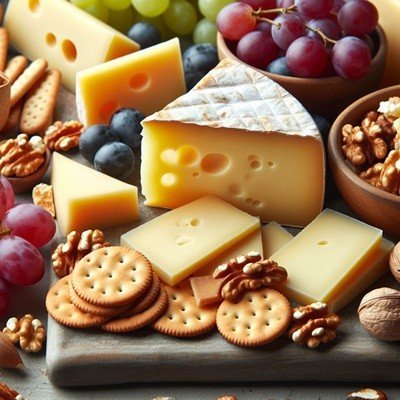Gruyère enjoys fame as one of Switzerland’s most renowned cheeses across continents. Taking its name from the charming medieval village where local dairy farmers first perfected the recipe using raw cow’s milk and traditional copper vats, every wheel of authentic Gruyère carries the Gruyères Switzerland designation. This Protected Designation of Origin certification legally mandates upholding exacting production standards set in the 12th century.
Beyond European cheese trays, melty Gruyère elevates French onion soup, complements charcuterie, and adds decadent depth across cuisines from fondues to everyday cooking. From the sublime grassy, nutty, and fruity notes to the signature pale yellow interior speckled with tiny holes, Gruyère balances sweet and salty flavors with a crystalline texture and creamy meltability. We unravel the essence of this alpine tradition while guiding you on taste profiles, wine pairings, serving ideas, and cooking applications for savoring Switzerland’s finest.

WHAT IS GRUYÈRE CHEESE?
Hailing from medieval village creameries in Switzerland’s lush Gruyères valley, authentic Gruyère has achieved global fame among fine cheeses for its distinctive flavor and supple yet firm texture. Classified as a hard mountain cheese, the pale yellow interior of Gruyère wheels is carefully aged for 6 to 12 months to achieve signature crumbly crystals infused alongside tiny eyes. Milk sourced from local Swiss cows grazing on rich grass and wildflowers carries delicate herbal and floral notes through the cheesemaking process spanning several seasons.
Beyond European cheese trolleys, the finest quality Gruyère designation from Switzerland graces everything from quiches and gratins to hot toasted sandwiches with its clean, smooth and slightly nutty flavor profile. It effortlessly elevates any dish by melting beautifully, lending pleasant salty and sweet hints to complement other ingredients. Artisanal producers in Gruyères still craft this rindless cow’s milk cheese by hand using traditional copper cauldrons as they have for centuries, creating a luxuriously creamy interior speckled with holes that beautifully showcases excellence in dairy heritage and cheesemaking mastery.
WHAT DOES GRUYÈRE TASTE LIKE?
The smooth, creamy texture of fine Gruyère cheese beautifully balances contrasting flavors for a memorable eating experience. Rindless wheels carefully aged 6 months develop signature nutty, fruity essences with pleasant lingering sweetness offset by mild saltiness. At a full 10 to 12 months maturation, bolder earthy and herbaceous notes emerge to complement the distinct nuttiness. Milk from cows grazing Switzerland’s wildflower-dotted mountain pastures carries delicate floral aromas through the cheese as it ripens, while tiny pockets add delightful texture. Yonger Gruyère delivers a more pronounced grassy, nutty flavor before giving way to increasingly complex secondary tastes over time. From a gentle rounded profile to more intense robustness, Gruyère’s flavor spectrum has secured its global appeal.
HOW TO PRONOUNCE GRUYÈRE
The name of this famous Swiss cheese ties directly back to the remote medieval Alpine village bearing the same title where traditional recipes first originated. As a French word, Gruyère presents pronunciation challenges for the uninitiated. But unlocking the proper enunciation brings you one step closer to cheese expertise. By carefully sounding out each syllable, the correct pronunciation becomes clear.
Breaking it down: “Gruyère” = GROO – YAIR
The beginning “GR” sounds almost like a low gargle at the back of the throat before continuing. Let the “OO” vowel softly linger on the tongue while lips form a slight pucker shape. Finally, “YAIR” clips the end for an abrupt finish. Practicing the lyrical multi-syllabic intonations helps ingrain the authentic French pronunciation. With just a few careful attempts enunciating every sound, you can confidently pronounce Gruyère like a cheese connoisseur. Say it out loud: “GROO-YAIR” for mastering the name of Switzerland’s most iconic cheese.
WAYS TO USE GRUYÈRE CHEESE
The smooth nutty sweetness of French Alpine Gruyère adds indulgent flair across cooking applications:
Hot Melty Dishes
Gruyère beautifully blankets Parisian ham sandwiches, fills omelets or tops onion soup when melted into irresistible ooziness. Equally iconic in quiches, tarts, pasta bakes, gratins.
Entertaining
A charcuterie cheese board gains elegance with Gruyère alongside cured meats and fruit. Fondues also incorporate melted Gruyère for dipping celebration.
Enhancing Flavor
Stir Gruyère into risottos, mashed potatoes or compound butters before serving over steaks or seafood. Adds tasty punch without overpowering other ingredients.
With its crystalline yet creamy texture and versatile flavor profile, Gruyère effortlessly elevates everything from weekday meals to dinner parties. This sublime Swiss cheese satisfies cravings through an extraordinary melting quality.
THE BEST WINE PAIRINGS
The supple nutty essence of fine Swiss Gruyère deserves wine pairings equally as nuanced. Light to medium-bodied red varietals with touches of fruity sweetness beautifully balance the salty undertones and creamy texture. For white wines, semi-dry vintages with medium body and crisp acidity cut through the rich flavors nicely. Top red recommendations include elegant Pinot Noir, Grenache blends from the Rhône Valley, and fruity Beaujolais with berry hints. Whites like aged Riesling, unoaked Chardonnay, Chenin Blanc and Sauvignon Blanc make refined choices. Given Gruyère’s versatile range from young and grassy to bold complexity with age, flexible food-friendly wines only enhance the indulgent cheese experience. From casual snacking to upscale soirees, keep these winning Gruyère and wine matches on hand for effortless entertaining and everyday enjoyment.
BEST SUBSTITUTES FOR GRUYÈRE CHEESE
When a recipe calls for authentic Gruyère but none is available, several worthy cheese alternatives replicate its essence well:
- Comté: French cheese with slightly milder flavor, similar texture
- Emmentaler: Also a Swiss cheese; softer than Gruyère but nicely melty
- American Swiss: Good mass quantity substitute for fondues
- Jarlsberg: Norwegian Swiss-style cheese, solid Gruyère replacement
- Raclette: Firm like Gruyère, more intense smoky flavor
- Beaufort: French Alpine cheese with comparable firm, creamy profile
While no other cheese perfectly mimics renowned Gruyère, its smooth and nutty notes shine through these substitutions above. Their shared European heritage ensures comparable quality and performance for all Gruyère’s best applications – from fine wine pairings to elegant charcuterie to melting beautifully in hot dishes. With multiple options to choose from, no recipe gets derailed when our Swiss headliner happens to be missing from the marquee.
EASY GRUYÈRE RECIPES
